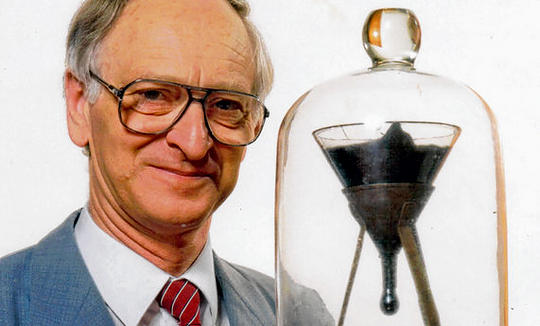
Science isn’t always accessible to everyone in a family; after all, many parents simply do not have or make time to follow the latest scientific research being conducted. Sure, we appreciate advancements in technology, medicine, and Mars exploration, but the nitty-gritty of scientific research tends to get overlooked. Then there is the actual complexity of much scientific discovery that places it out of the reach of the untrained, let alone the understanding of children. Your lives may be busy, and your children may be quite young, but this year you, and your children, are invited to slow down – way down – and think about the longest running science experiment in the world that is currently being conducted by Professor John Mainstone at the University of Queensland. It is simply called the Pitch Drop Experiment.
Although Professor Mainstone has spent over two decades on the experiment, it actually began long before his time. According to the website of the School of Mathematics and Physics at University of Queensland Australia, “the first Professor of Physics at the University, Professor Thomas Parnell, began an experiment in 1927 to illustrate that everyday materials can exhibit quite surprising properties. The experiment demonstrates the fluidity and high viscosity of pitch, a derivative of tar once used for waterproofing boats. At room temperature, the pitch feels solid – even brittle – and can easily be shattered with a blow from a hammer. It’s quite amazing then, to see that pitch at room temperature is actually "fluid” (though not in the sense that most people think of when cogitating on the word fluid).
In 1927 Professor Parnell heated a sample of pitch and poured it into a glass funnel with a sealed stem. Three years were allowed for the pitch to settle, and in 1930 the sealed stem was cut. From that date onward, the pitch has slowly dripped out of the funnel – so slowly that now, 83 years later, sometime in 2013, only the 9th drop is expected to fall.
Even though the last drop fell on 28 of November 2000, none of the previous 8 drops over the preceding 70 years has ever been witnessed or recorded. In 2000, a video camera was set up for the event, but unfortunately malfunctioned on the actual day of the drop. Professor Mainstone himself figures he missed witnessing at least one of the drops by as little as 15 minutes. Now, there are three cameras on the experiment at all times and anyone can check the University’s webcam online to view the experiment in real time (think of watching paint dry – really slow paint).
According to Wikipedia, the experimenters have calculated that the pitch has a viscosity approximately 230 billion times that of water. In the 12 years since the 8th drop fell, gravity has relentlessly been working on the 9th one. At least this time, if the cameras are properly rolling, you and your children will be able to witness a bit of scientific discovery; even if you aren’t watching when it actually falls.
For more on this long, though simple, experiment, visit the official university site here, or simply do a web search using the phrase “pitch drop”. And don’t forget to show it to your kids!
Photo by: Irish Times



